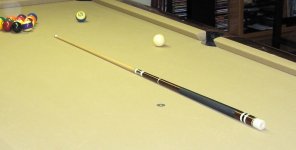fact is that the soft rubber bumper absorbs vibration. The bigger it is, the more effective it is at doing so. The softer it is, the more effective it is at doing so. With no bumper at all, there's nothing in the cue to absorb the vibration. So upon impact, vibrations flow back & forth across the length of the cue, virtually uninhibited. This increases the sensation in your grip hand because the cue can freely vibrate. That vibration increases the audibility of the impact. It is especially noticeable on side spin shots, where the cue is flexed & once the ball is gone the cue reflexes back to it's original shape, acting as a pendulum until it reaches equilibrium. This is very easily felt. A center ball shot is solid with a single jolt, no continuing vibrations. If you hit off center when you think you are hitting center, then your cue tells you that you hit wrong. This is what players refer to as feedback. It's too intense for some players, as they prefer a more mellow & smooth feel. So a bumper is good for them. Personally, i prefer something moderate, middle. I use bumpers not only to protect the cue, but also to tune it, tame it down. Old brunswick catalogs didn't use the term bumper. They called them noise suppressors, or vibration dampeners. That's exactly what they are. The protection was an afterthought, a byproduct.
Point is that bumpers have been misunderstood for a long time. Many builders don't even consider the bumper as a viable component for tuning the hit of a cue. In recent years the concept has been rediscovered, hence all the bumperless cues. But the general cue buying public has long forgotten the original purpose of a bumper & now everybody seemingly assumes it's for protection, when it's not. Even a lot of builders think it's only for protection. And i guess, in past decades it has become just that. The purpose has changed. But you cannot dismiss the fact that with that protection comes the byproduct of noise suppression and vibration dampening. The purpose may have changed over the years, but the effects haven't. I think it's cool that many cues are being built without bumpers nowadays. It's a tuning option that alters the cue's dynamics, which opens the door to more people being able to find a cue that works best for them. That's a good thing because we are all different, and prefer different things. Obviously some folks like that full feel. I personally want it tamed down a bit. Some guys like it tamed down all the way. As i said before & i'll say again, every component on a cue makes a difference, even something as seemingly insignificant as a bumper.

